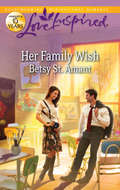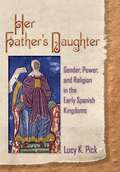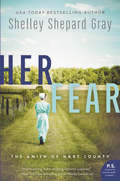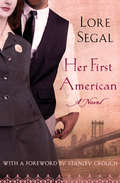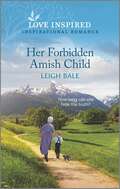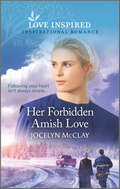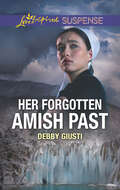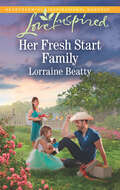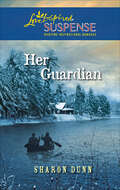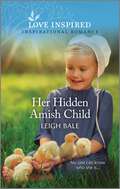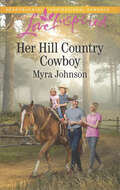- Table View
- List View
Her Every Move
by Kelly IrvinHe&’s a cop trying to stop a serial bomber. And she&’ll stop at nothing to clear her own name. When a deadly bomb goes off during a climate change debate, librarian and event coordinator Jackie Santoro becomes the prime suspect. Her motive, according to Detective Avery Wick: to avenge the suicide of her prominent father, who was accused of crimes by a city councilman attending the event. Though Avery has doubts about Jackie&’s guilt, he can&’t exonerate her even after an extremist group takes responsibility for the bombing and continues to attack San Antonio&’s treasured public spaces. As Jackie tries to hold her shattered family together, she has no choice but to proceed with plans for the Caterina Ball, the library system&’s biggest annual fundraiser. But she also fears the event provides the perfect opportunity for the bomber to strike again. Despite their mistrust, Jackie and Avery join forces to unmask the truth—before the death toll mounts even higher. Bestseller Kelly Irvin is back with a nail-biting romantic suspense where nothing is certain until the very last page. Praise for Her Every Move:&“A gripping story that will have you on the edge of your seat until &‘The End.&’&”—Patricia Bradley, author of The Logan Point Series, Memphis Cold Case Novels, Natchez Trace Parkway Rangers series &“Explosive, tender, and races all the way through!&”—Jennifer Graeser Dornbush, author, screenwriter, and forensic specialist Stand-alone romantic suspenseFull-length novel, approximately 90,000 wordsIncludes discussion questions for book clubs
Her Family Wish
by Betsy St. AmantTaking pictures of other people's happiest moments is the perfect job for Hannah Hart. Secretly fearing that she won't ever have a family of her own, Hannah prefers to hide behind the camera. Until she meets assistant principal Jude Bradley, whose twelve-year-old daughter instantly bonds with Hannah. Jude might just be the man to give Hannah a reason to smile-if he can let go of the past. The more Hannah and Jude discover they have in common, the more Hannah wonders if there's a family in her future after all....
Her Father’s Daughter: Gender, Power, and Religion in the Early Spanish Kingdoms
by Lucy K. PickIn Her Father's Daughter, Lucy K. Pick considers a group of royal women in the early medieval kingdoms of the Asturias and of León-Castilla; their lives say a great deal about structures of power and the roles of gender and religion within the early Iberian kingdoms. Pick examines these women, all daughters of kings, as members of networks of power that work variously in parallel, in concert, and in resistance to some forms of male power, and contends that only by mapping these networks do we gain a full understanding of the nature of monarchical power. Pick's focus on the roles, possibilities, and limitations faced by these royal women forces us to reevaluate medieval gender norms and their relationship to power and to rethink the power structures of the era. Well illustrated with images of significant objects, Her Father's Daughter is marked by Pick's wide-ranging interdisciplinary approach, which encompasses liturgy, art, manuscripts, architecture, documentary texts, historical narratives, saints' lives, theological treatises, and epigraphy.
Her Fear: The Amish of Hart County
by Shelley Shepard GrayIn New York Times bestselling author Shelley Shepard Gray’s latest novel of suspense in her Amish of Hart County series, an EMT falls for a woman with ties to an Amish community where people are dying similar, suspicious deaths.Sadie Detweiler never imagined she’d move to Kentucky, yet here she is: a pregnant, unmarried Amish girl banished by unforgiving parents to live with kin she barely knows. The men are gruff and her cousins are secretive. Worst of all, elderly matriarch Verba becomes mysteriously ill shortly after Sadie moves in. When EMT Noah Freeman arrives, Sadie immediately notices he’s unlike any other Amish man she’s met. Noah is warm, confident, and has an easy way with practically everyone in the community, both Amish and English. Though Sadie is drawn to him, she has little hope he will reciprocate her feelings once he learns she’s with child.Noah can’t understand how a girl as sweet and lovely as Sadie ended up sleeping on a cot in Verba Stauffer’s kitchen. He also senses Sadie is terrified of something. Concerned, he checks up on her. Eventually they strike up a friendship and soon their attraction is undeniable. When Verba later dies at the hospital and her death is followed by two others, Noah’s boss wants him to dig around the Amish community for clues. He agrees—for Sadie’s sake—because only the truth will keep her safe and by his side.
Her Firefighter Hero: The Cowboy's Twins Her Firefighter Hero Her Texas Family (Men of Wildfire #1)
by Leigh BaleA young fireman’s widow finds that her heart and home are warming to a new man on her husband’s former crew in this inspirational romance.Megan Rocklin is trying hard to pick up the pieces. A year after her fireman husband's death, she has managed to keep the family diner going and tend to her two active children, June and Caleb. She's sure that's all she can handle—and then Jared Marshall asks Megan to cater the meals for his hotshot crew.With his rugged good looks, the new fire management officer for Minoa, Nevada, turns many heads—but his heart leads him straight to Megan. She's promised herself she'll never date another firefighter. But determined Jared refuses to give up on the family meant to be his . . .
Her First American: A Novel
by Lore SegalHailed by the New York Times as coming &“closer than anyone to writing The Great American Novel,&” Lore Segal stuns with this passionate love story of a refugee from Hitler&’s Europe and a witty, hard-drinking black intellectual For Ilka Weissnix, everything is new. Having recently arrived in the United States, she is determined to escape the immigrant communities of New York and boards a train headed west to discover &“the real America.&” She finds Carter Bayoux &“sitting on a stool in a bar in the desert, across from the railroad.&”Older, portly, experienced, and black, Carter is magnetic. To Ilka, he exemplifies the values and cultures of a changing America. In order to understand her new country and her new love, Ilka throws herself into Carter&’s dizzying world, nurses him through his bouts of depression and his alcoholism, and becomes fascinated by stories of his amorous past. But Carter&’s ghosts are ever present, and soon Ilka finds herself torn between saving him and saving her own future.With a foreword by Stanley Crouch, Her First American is the poignant story of an immigrant experience in a country of endless possibilities and of a rich and breathtaking love that is doomed from the start.
Her Forbidden Amish Child: An Uplifting Inspirational Romance (Secret Amish Babies #2)
by Leigh BaleNo one can ever know the truth… Especially her son. Four years ago, having a child out of wedlock changed everything for Tessa Miller—including her engagement to Amish farmer Caleb Yoder. Now she&’s determined to provide a better life for her son…even if it means working for her ex-fiancé. Only spending time with Caleb makes it harder to keep her past a secret. Will revealing the truth lead to forgiveness…and a second chance together?From Love Inspired: Uplifting stories of faith, forgiveness and hope.Secret Amish Babies Book 1: The Midwife's Christmas WishBook 2: Her Forbidden Amish Child
Her Forbidden Amish Love
by Jocelyn McClayFollowing your heart isn’t always simple when you have to choose between your community and the man you still love . . . Five years ago, Hannah Lapp walked away from Gabe Bartel, crushing their dreams of a future together. She couldn’t break her parents’ hearts by marrying a Mennonite man and leaving the Amish community. Now Gabe is back as her town’s new EMT. And Hannah’s heart is on the line all over again, because this time she can’t imagine letting him go . . . From Harlequin Love Inspired: Uplifting stories of faith, forgiveness and hope.
Her Forbidden Christmas Match: An Uplifting Inspirational Romance (Seven Amish Sisters #5)
by Emma MillerAn Amish woman. A man who&’s lost his way. Can they find love this Christmas? After leaving a harsh religious community, widower Aaron Raber won&’t let anything separate him from his five-year-old daughter—not even his new job on a construction site. But that&’s before he meets the disapproval of Willa Koffman. The stubborn Amish woman is convinced she has the perfect solution: she&’ll babysit the little girl while the cranky Mennonite works. But neither expects their growing attraction. Now Willa must make a choice before Christmas—between the community she loves…and the man she doesn't want to live without.From Love Inspired: Uplifting stories of faith, forgiveness and hope.Seven Amish Sisters Book 1: Her Surprise Christmas CourtshipBook 2: Falling for the Amish Bad BoyBook 3: The Teacher's Christmas SecretBook 4: An Unconventional Amish PairBook 5: Her Forbidden Christmas MatchBook 6: The Widower Takes a Wife
Her Forever Cowboy
by Debra CloptonMule Hollow, Texas, is chock-full of handsome cowboys ready to say "I do." So veterinarian Susan Worth moves in, dreaming of meeting Mr. Right. He's most certainly not the gorgeous rescue worker blazing through town on a motorcycle. Cole Turner is a sixth-generation Mule Hollow rancher, but he's all about roaming Texas to save everyone but himself. The hurt hidden deep inside his heart keeps him from settling down. But Susan is determined--and knows just how--to make him her forever cowboy.
Her Forgiving Amish Heart: Her Forgiving Amish Heart His Surprise Son The Firefighter's Twins (Women of Lancaster County)
by Rebecca KertzCan she forgive and forget—and fall in love?A Women of Lancaster County StoryLeah Stoltzfus hasn’t forgiven Henry Yoder for betraying her family years earlier. But Henry is a changed man. And wants to prove it to Leah. Then a family secret is unearthed, shaking Leah to her core. Henry’s determined to support her in every way. If only she could leave the past behind and open her heart to him…
Her Forgotten Amish Past (Love Insp Susp True Lp Trade Ser.)
by Debby GiustiA woman on the run with amnesia seeks shelter with an Amish man and his family, in this inspirational romantic suspense from a USA Today–bestselling author.Someone wants Becca Troyer dead, but who or why is a mystery to her. Seeking refuge at the home of Amish farmer Zeke Hochstetler is her only hope to stay one step ahead of the killer. With every clue she finds about her past leading to more confusion, Becca and Zeke must untangle the truth before her pursuer discovers where she’s been hiding.
Her Forgotten Cowboy: A Fresh-Start Family Romance (Cowboy Country #10)
by Deb KastnerShe can’t remember the pastHe can’t imagine a future without her in Cowboy CountrySuffering amnesia after a car accident, Rebecca Hamilton arrives back in Serendipity, Texas, pregnant and seeking the baby’s father—her estranged husband, Tanner. Returning to the ranch house they once shared is her best chance at regaining her memories. But will recalling the tragic reason they separated only drive a bigger wedge between Rebecca and the man she’s falling for all over again?
Her Forgotten Life
by Maggie K. BlackFrom USA TODAY bestselling author Maggie K. Black… To protect her baby she needs to remember who she is. Gunshot victim Sara Kilpatrick has no memory of her life before she ended up in an Amish farmhouse—or why someone&’s trying to kill her. But when clues lead to her own gravestone, Sara discovers a deadly conspiracy—and a husband and baby she doesn&’t remember. And uncovering the truth could cost her everything…including the family she just found.From Love Inspired Suspense: Courage. Danger. Faith.
Her Fresh Start Family: The Amish Suitor Reunited With The Bull Rider Her Fresh Start Family (Mississippi Hearts #1)
by Lorraine BeattyA young widow finds a new life and a new love in a little Mississippi town—but will a secret bring it all crashing down?Struggling with a tragic loss, widow Nina Johnson seeks a fresh start in a small Southern town. Then she meets handsome veteran Bret Sinclair and his sweet daughters. Bret’s no stranger to loss, and his companionship is the solace Nina’s been searching for.Until a dark secret from Bret’s past is exposed, threatening to break two hearts . . .
Her Guardian
by Sharon DunnA woman shares a safe house with a handsome bodyguard while awaiting the trial of her childhood abductor in this inspirational romance.Julia Randel was thirteen when she was kidnapped by a cult leader. It took her seven years to escape. Two years later her captor’s trial is about to begin—and so are threats from his loyal followers. Julia is relieved when her father hires bodyguard Gavin Shane, but she’s furious when he rushes her to a safe house. After years under lock and key, she doesn’t want to be forced into hiding again. But with cultists seeking to stop Julia’s testimony at any cost, it’ll take both Julia and her determined protector to set her free for a new life—and new love.
Her Handyman Hero: An Amish Arrangement Claiming Her Cowboy Her Handyman Hero (Home to Dover)
by Lorraine BeattyAn ex-DEA agent masquerades as a handyman for a chance to keep his family together in this heartwarming inspirational romance.Reid Blackthorn arrives in Dover on a personal mission—to make sure his terminally ill brother gets a chance to meet his daughter. Deceiving little Lily’s guardian isn’t his intention. Yet once Tori Montgomery mistakes Reid for her new handyman, he knows it’s the only way to be close to his niece.Tori is honoring her friend’s last wish by keeping Lily away from her father’s family. And once she learns who Reid truly is, she realizes there’s too much at stake—including custody of Lily—for her to fall for the former DEA agent. But in keeping a promise, is she losing out on her chance for a happily-ever-after?
Her Hidden Amish Child: An Uplifting Inspirational Romance (Secret Amish Babies #4)
by Leigh BaleCan a little girl… Heal the wounds of the past? When Faith Mast inherits her great aunt&’s Amish farmhouse, she needs to sell it fast—before someone in the community discovers her daughter&’s real identity. Accepting Josiah Brenneman&’s help with repairs is risky but might be the perfect solution. That is, until the man she once loved and left wins the little girl&’s heart. With secrets still between them, will Faith choose the future she&’s always wanted…or repeat the past?From Love Inspired: Uplifting stories of faith, forgiveness and hope.Secret Amish Babies Book 1: The Midwife's Christmas WishBook 2: Her Forbidden Amish ChildBook 3: An Amish Christmas WishBook 4: Her Hidden Amish Child
Her Hidden Hope: Colorado Grooms (Colorado Grooms #4)
by Jill LynnEnjoy this heartfelt romance from Jill Lynn, part of the sweet and emotional series Colorado Grooms.She once trusted him with her heart… but will she ever trust him with the truth?With only two weeks to renovate her family’s Colorado B and B, struggling single mom Addie Ricci can’t turn away help. Especially not when it’s her handsome high school sweetheart, Evan Hawke, who’s offering to pitch in. As they repair the B and B, Addie and Evan also begin rebuilding their relationship…until a secret from their past threatens to bring it all crashing down. From Love Inspired: Uplifting stories of faith, forgiveness, and hope.Colorado Grooms:Book 1: The Rancher’s Surprise DaughterBook 2: The Rancher’s Unexpected BabyBook 3: The Bull Rider’s Secret Book 4: Her Hidden Hope Book 5: Raising Honor
Her Hidden Legacy (Double R Legacy #4)
by Danica FavoriteShe thought she knew what she wanted… until she met him. To save her magazine, RaeLynn McCoy must write a story about the Double R Ranch—and face her estranged family. But when ranch foreman Hunter Hawkins needs help caring for the children temporarily in his custody, it becomes impossible to do her job and leave without forming attachments. After raising her siblings, RaeLynn enjoys her career-focused life, but with Hunter, she&’s starting to dream of family… A DOUBLE R LEGACY ROMANCEFrom Love Inspired: Uplifting stories of faith, forgiveness and hope.Double R LegacyBook 1: The Cowboy's SacrificeBook 2: His True PurposeBook 3: A True CowboyBook 4: Her Hidden Legacy
Her Hill Country Cowboy (Large Type (dtc) Li Trade Ser.)
by Myra JohnsonA single father clashes with a former social worker, before realizing she’s just what his family—and his heart—needs. From the award-winning author.Single father Seth Austin will do anything for his children. So when he discovers the new housekeeper his grandmother hired for their guest ranch is a former social worker, he plans to keep his family far away from Christina Hunter. Seth once almost lost custody of his beloved kids because of an overzealous social worker. Problem is his children adore Christina and her sweet service dog—and he’s starting to fall for her, too. Recuperating from an accident, Christina is determined to slowly ease back into her old life. But the more time she spends with them, the more she realizes that her future might be with the cowboy and his family.
Her Holiday Family
by Winnie GriggsTHE CHRISTMAS CHILDREN Reserved widow Eileen Pierce never considered herself the kind of woman who was cut out to be a mother. She wouldn't know what to do with one child, much less ten. But when handyman Simon Tucker is stranded in town with a group of young orphans at Christmastime, she discovers she can't just turn them away. Simon knows there's more to Eileen than meets the eye. Though his easygoing demeanor immediately clashes with her buttoned-up propriety, Simon's kindness soon melts Eileen's stern facade. Simon and the children already upended Eileen's quiet, orderly life. Will they do the same to her guarded heart? Texas Grooms: In search of their brides...
Her Holiday Family (Kirkwood Lake #5)
by Ruth Logan HerneA soldier returns to his hometown and finds love, faith and forgiveness in this inspirational romance from a USA Today–bestselling author.Home for the HolidaysWhen her café goes up in smoke, Tina Martinelli decides to make a big change. She plans to leave Kirkwood Lake and start over—somewhere without the haunting memories of family and failure. But just as she’s plotting her new life, her girlhood crush Max Campbell returns to town—and suddenly takes notice of Tina all grown up. Having retired from his military career, Max’s ready to start over, too. He’s given his heart to her. Now, if only Max can convince Tina to stick around this Christmas—and forever after.Kirkwood Lake: A town full of heart and hope
Her Holiday Family and The Sheriff's Christmas Twins
by Winnie Griggs Karen KirstSurprise Christmas blessingsHer Holiday Family by Winnie Griggs Reserved widow Eileen Pierce never considered herself cut out to be a mother. But when handyman Simon Tucker is stranded in town with ten young orphans at Christmastime, she can't just turn them away. Though Simon&’s easygoing demeanor clashes with Eileen&’s buttoned-up propriety, his kindness melts her stern facade. Soon Simon and the children upend Eileen's quiet, orderly life. Will they do the same to her guarded heart?The Sheriff's Christmas Twins by Karen Kirst Convinced that Allison Ashworth deserves better, Sheriff Shane Timmons has always tried to remain aloof. But with Allison in Gatlinburg for the holidays and caring for two motherless babies, Shane wants to help her. Allison has always been drawn to Shane, but he never seemed to look her way. Now, spending time with him and the twins gives her hope that her dreams of motherhood—and a life with Shane—may come true.
Her Holiday Fireman
by Kathleen Y'BarboFrom his first encounter with the feisty redhead, widower and fire marshal Ryan Owen knows he's in trouble. He's in Vine Beach to heal, not to find romance. As for Leah Berry, she's come home strictly to lay claim to her family's restaurant and fend off developers. Leah is infuriated when Ryan shuts down the restaurant on violations. Both are determined to have their way, even as something unexpected starts blossoming between them. They'll need to learn the hardest thing about love and faith-letting go.

